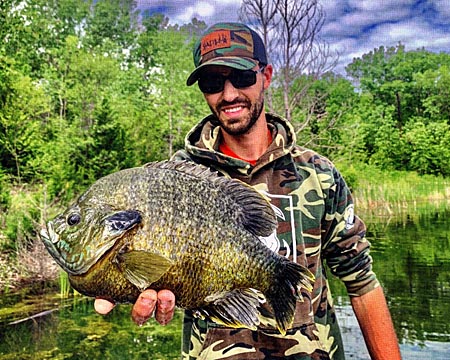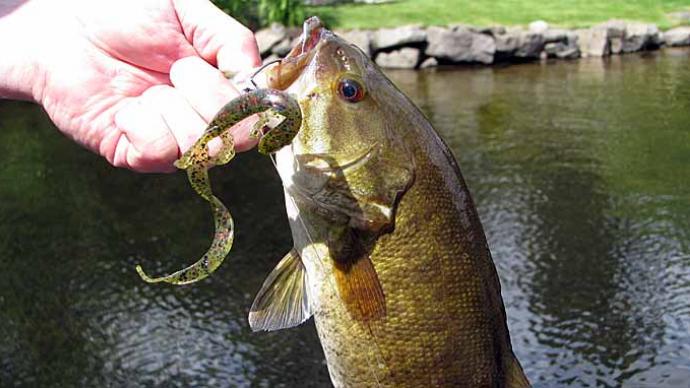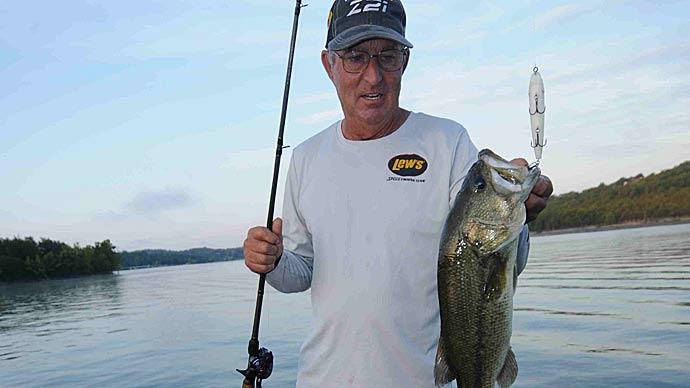
A certain sense of urgency comes over fish when the temperature begins to drop. Bass, bluegill, and crappie typically get into a comfortable state of being after the post-spawn as they feed on a new food chain and settle into that summer pattern we all hear about. They seem to stay in this mode throughout most of the summer. However, you may notice in your waters, dynamics begin to change rapidly after the first cold front of fall. In this article, I will dive into how fish change as the temperature drops and how anglers can capitalize on that.
When we look at the yearly cycle of a game fish, we can see a few different modes fish are in throughout the year. From the moment the first warm front moves in after winter, a bass is completely occupied with the spawn. A big bass, bluegill, or crappie is fully aware that they need to pack on some weight to survive the spawn (or if they aren't aware of it, their instincts are). Even though a big fish may only be on a bed for 2-3 days, their instincts have them preparing for those two days for weeks or even months before the spawn. And then, during the spawn, those fish eat mainly out of aggression. After the spawn, a fish may continue to be aggressive due to the hunger caused by all the calories expended, producing eggs, and protecting the nest.
However, after a big fish has gained its weight back after the spawn, its instincts are back to focusing solely on survival and growth. And throughout most of the summer, survival of a big game fish is not that difficult. Getting to those large sizes was extremely difficult, but that fish's focus changes once there. The pond is full of the recent and ongoing spawns of baitfish and gamefish, and the biggest fish is quite comfortable in the 75-80-degree water. This comfortable summer stage is the most painful time for many anglers because bass do not chase baits except when hungry once or twice a day. A big fish has practically no sense of urgency because they have many calories they need from the big meals they tend to consume. In that higher water temperature, a big fish is typically content to stroll around slowly or stay within the safety of deep structure all day—or even all summer. The instincts of fish in summer are not telling them to beef up for the spawn or to pack on weight for the winter. In the summer, a fish is probably the most carefree of any time of the year, if you will.
However, as I mentioned, that first cold front can make a fish snap out of its lazy summer pattern and into a far more aggressive nature. Fish have a way of knowing winter is coming, and just like all other animals, their instinct is to prepare their bodies for shorter days and cooler water. During these first few cold fronts, you can benefit from changing your view as an angler. Instead of hitting the fish on the head with your lure, you can experiment with some faster moving baits. The strike zone of a big fish may increase dramatically because they can no longer slowly amble around; they need to put on weight to ensure survival through the winter.
Since these fish have a new, more aggressive mindset, anglers can target them differently. This time of year, I put away the Texas rig and the Senko and picked up the spinnerbait, the chatterbait, and mostly, the lipless crankbait. In my opinion, the lipless crankbait is the ultimate tool when fishing falling water temperatures. The most remarkable thing about this lure is the fact that it has such a tight side-to-side action. In cold water, baitfish do not have a very erratic action, and most baitfish, especially shad, have a very tight action. The lipless crankbait imitates this colder baitfish perfectly. It can also be fished in nearly every stretch of the water column.
My favorite pattern with a lipless crankbait, or even a chatterbait, is to cast it to a windblown bank and slowly pull the lure off the bank, letting it fall on a slack line between cranks. A bass that has recently moved up shallow to chase bait will not hesitate to hit a shad imitation like this, pulled, and dropped in front of her face.
Whenever fishing in falling water temperatures, I look for a shoreline game fish to follow. With all the commotion, moving, and dirty water, this makes for many new ambush points for big bass. Even if your pond has clear water, an area that becomes dirty because of a strong wind can hold some incredible fishing opportunities while it lasts. And as you can imagine, a flashy bait like a spinnerbait or lipless crankbait can be the ticket in that dirty water with the wind pushing against it. I view wind as a dinner bell to a big fish. If a fish is in a feeding mode, it will be far more attracted to the bank with the most moving water. My theory is smaller plankton, tiny bits of food, get pushed into the bank with the wind, and baitfish follow.
Another great tactic, for calmer conditions or clearer water, is to throw a swimbait. With these big fish prowling for calories, sometimes a 5-6" swimbait is precisely what they seek. I would recommend a shad imitation in colder water, but if that is not a forage species in your pond, a bluegill-colored bait would be fine. Again, I like to throw this lure past the obvious ambush points in the pond. That giant bass may not have hit that bait a month ago, but since her strike zone has increased with the falling temps, you may be surprised how willing a big bass is to travel to eat that big bait. As I've always stated, the bigger the bait, the bigger the strike zone for a monster fish.
I do not claim to know nearly as much about catching crappie and bluegill as I do bass, but I have also found that falling water temperatures have provided some of my best panfishing days. Although the panfish may not be near as mobile as the bass in falling water temperatures, they seem more willing to bite a lure than in the hot summer months. I have found that in or around deep water, brush piles can hold an insane amount of big crappie and bluegill this time of year. If you can position your boat close to the structure, vertical jigging can be a killer tactic to bring up the fattest panfish in your pond.
I prefer a GULP 2-inch minnow on a 1/32 oz jighead. This bait is irresistible to crappie, and while its size may deter a few smaller bluegill, it is a perfect meal for a big bull gill. If there is deep cover close to where you know bluegill and crappie spawn in your pond, I would always hit that area with smaller jigs to see if any panfish are there. Deep cover, close to spawning areas, seems to hold big panfish year-round, even in cold months. One important thing to remember while casting for big panfish is that in the colder temps, it may be beneficial to use the lightest jig you can, depending on wind conditions. Everything is moving slower in the colder water, and if you can get away with a 1/50 oz jighead, your bite ratio may increase.
Another thing you may notice while fall fishing is that fish appear to be at their healthiest. To survive the winter in your pond, those fish must put on mass to make it through the unknown of winter. Although they may not be as heavy as they are during the spawn, the fall is when a fish should be at their second heaviest of the year. If you saw a monster bream or bass on a bed in the spring that you couldn't put a hook into, this may be your chance. That fish has a new sense of urgency, and she is packing on the weight for the winter. A window is currently open as the temperature falls, before your pond locks up, or before the water gets too cold for the bass to chase baits. I'm going to stop writing and go fishing. I wouldn't be offended if you stopped reading and went fishing.
Reprinted with permission from Pond Boss Magazine



